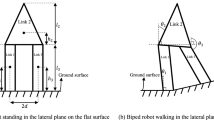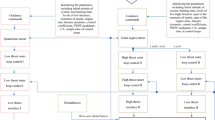Abstract
Tensor product model transformation could find a convex polytope representation similar to the Takagi-Sugeno (TS) fuzzy model from the given quasi-linear variable parameter (quasi-LPV) system model. TP models have proposed many convex hulls manipulated methods in previous studies, but these convex hulls are designed based on classical sampling methods, and local extrema refinement methods are often ignored by these classical sampling methods. Therefore, this paper proposes a convex hull manipulate method by adding local extremum to refine the partition of the entry functions, and the method is proposed based on vary input quasi-LPV state space models. First, the TP model transformation is extended by linearizing the weighting functions that is obtained via different ways of substituted entry functions, the given TS fuzzy model is converted into an alternative TS fuzzy model, and the converted TS fuzzy models are presented with different number of inputs. The difficulty level of controller design is reduced by changing the antecedents of the fuzzy sets, so the optimized control can be achieved via linear matrix inequalities (LMIs). Secondly, the local extrema refinement strategy is used to implement the TP model transformation, the manipulated method of convex hull is expanded. Finally, the GOOGOL’s two-wheeled self-balancing robot model is employed as the controlled object, and the tracking controller is attached for verification. At the same time, different external disturbances are considered to be added to the left and right wheels of the robot. The simulation results show that, by combining the state-space model with vary input variables and the local extrema refinement strategy, the designed controller achieved better control performance.
Similar content being viewed by others
References
F. Chang, B. Shi, X. Li, G. L. Zhao, and S. Huang, “Local extrema refinement-based tensor product model transformation controller with problem independent sampling methods,” Asian Journal of Control, vol. 23, no. 3, pp. 1352–1366, 2021.
S. Nagy, Z. Petres, P. Baranyi, and H. Hashimoto, “Computational relaxed TP model transformation: Restricting the computation to subspaces of the dynamic model,” Asian Journal of Control, vol. 11, no. 5, pp. 461–475, 2009.
V. C. S. Campos, L. A. B. Tôrres, and R. M. Palhares, “Revisiting the TP model transformation: Interpolation and rule reduction,” Asian Journal of Control, vol. 17, no. 2, pp. 392–401, 2015.
J. J. Pan and L. Z. Lu, “TP model transformation via sequentially truncated higher-order singular value decomposition,” Asian Journal of Control, vol. 17, no. 2, pp. 467–475, 2015.
Z. Szabó, P. Gáspár, S. Nagy, and P. Baranyi, “Control-oriented Qlpv modeling using TP transformation,” Proc. of 2009 European Control Conference (ECC), Budapest, pp. 2640–2645, 2009.
J. F. Cui, K. Zhang, and T. H. Ma, “An efficient algorithm for the tensor product model transformation,” International Journal of Control, Automation, and Systems, vol. 14, no. 5, pp. 1205–1212, 2016.
P. Baranyi, “Extracting LPV and qLPV structures from state-space functions: A TP model transformation based framework,” IEEE Transactions on Fuzzy Systems, vol. 28, no. 3, pp. 499–509, 2020.
K. Tanaka, H. Yoshida, H. Ohtake, and H. O. Wang, “A sum-of-squares approach to modeling and control of nonlinear dynamical systems with polynomial fuzzy systems,” IEEE Transactions on Fuzzy Systems, vol. 17, no. 4, pp. 911–922, 2009.
K. Tanaka, H. Ohtake, T. Seo, M. Tanaka, and H. O. Wang, “Polynomial fuzzy observer designs: A sum-of-squares approach,” IEEE Transactions on Systems, Man, and Cybernetics, Part B (Cybernetics), vol. 42, no. 5, pp. 1330–1342, 2012.
A. Szollosi and P. Baranyi, “Influence of the tensor product model representation of qLPV models on the feasibility of linear matrix inequality,” Asian Journal of Control, vol. 18, no. 4, pp. 1328–1342, 2015.
A. Szollosi and P. Baranyi, “Improved control performance of the 3-DoF aeroelastic wing section: A TP model based 2D parametric control performance optimization,” Asian Journal of Control, vol. 19, no. 2, pp. 450–466, 2017.
A. Szollosi and P. Baranyi, “Influence of the tensor product model representation of qLPV models on the feasibility of linear matrix inequality based stability analysis,” Asian Journal of Control, vol. 20, no. 1, pp. 531–547, 2018.
P. Baranyi, TP-model transformation based control design frameworks, series Control Engineering. Springer book, ISBN 978-3-319-19605-3, 2016.
G. L. Zhao, D. G. Wang, and Z. K. Song, “A novel tensor product model transformation-based adaptive variable universe of discourse controller,” Journal of the Franklin Institute, vol. 353, no. 17, pp. 4471–4499, 2016.
T. Zhang, M. Zhang, and Y. Zou, “Time-optimal and smooth trajectory planning for robot manipulators,” International Journal of Control, Automation, and Systems, vol. 19, pp. 521–531, 2021.
Z. Liu, N. Sun, Y. Wu, and Y. Fang, “Nonlinear sliding mode tracking control of underactuated tower cranes,” International Journal of Control, Automation, and Systems, vol. 19, pp. 1065–1077, 2021.
P. Korondi, “Tensor product model transformation-based sliding surface design,” Acta Polytechnica Hungarica, vol. 3, no. 4, pp. 23–35, 2006.
A. M. F. Pereire, L. M. S. Vianna, N. A. Keles, and V. C. S. Campos, “Tensor product model transformation simplification of Takagi—Sugeno control and estimation laws — An application to a thermoelectric controlled chamber,” Acta Polytechnica Hungarica, vol. 15, no. 3, pp. 13–29, 2018.
Y. Y. Kan, H. Zhen, and J. Zhao, “Tensor product modelbased control design with relaxed stability conditions for perching maneuvers,” Acta Polytechnica Hungarica, vol. 15, no. 3, pp. 45–61, 2018.
L. Kovács and G. Eigner, “Tensor product model transformation-based parallel distributed control of tumor growth,” Acta Polytechnica Hungarica, vol. 15, no. 3, pp. 101–123, 2018.
B. Takarics, A. Szollosi, and B. Vanek, “Tensor product type polytopic LPV modeling of aeroelastic aircraft,” Proc. of IEEE Aerospace Conference, pp. 1–10, 2018.
S. Chumalee and J. F. Whidborne, “Gain-scheduled H∞ control for tensor product type polytopic plants,” Asian Journal of Control, vol. 17, no. 2, pp. 417–431, 2015.
G. L. Zhao, H. X. Li, and Z. K. Song, “Tensor product model transformation based decoupled terminal sliding mode control,” International Journal of Systems Science, vol. 47, no. 8, pp. 1791–1803, 2016.
G. L. Zhao, W. Wu, and D. G. Wang, “Enhancement of the variable universe of discourse control by hammersley sequence-based TP model transformation,” Proc. of 2018 Eighth International Conference on Information Science and Technology, Cordoba, Spain, pp. 401–408, 2018.
G. L. Zhao and D. G. Wang, “Augmented TP model transformation-based parallel distributed compensation control design,” Asian Journal of Control, vol. 23, no. 10, pp. 315–330, 2021.
S. Kuntanapreeda, “Tensor product model transformation based control and synchronization of a class of fractional-order chaotic systems,” Asian Journal of Control, vol. 17, no. 2, pp. 371–380, 2015.
R. E. Precup, E. M. Petriu, M. B. Rǎdac, S. Preitl, L. O. Fedorovici, and C. A. Dragoş, “Cascade control system-based cost effective combination of tensor product model transformation and fuzzy control,” Asian Journal of Control, vol. 17, no. 2, pp. 381–391, 2015.
J. Kuti, P. Galambos, and Á. Miklós, “Output feedback control of a dual-excenter vibration actuator via qLPV model and TP model transformation,” Asian Journal of Control, vol. 17, no. 2, pp. 432–442, 2015.
Googol Technology LTD, Googol technology self-balancing robot modeling and simulation manual GBOT2001 V2014B: 10–16.
K. Tanaka and H. O. Wang, Fuzzy Control Systems Design and Analysis, John Wiley & Sons, New York, 2001.
T. Wang, Y. Bi, T. Hou, B. Liu, and J. Cui, “An efficient TP model transformation algorithm for robust visual servoing in the presence of uncertain data,” Acta Polytechnica Hungarica, vol. 17, no. 6, pp. 155–169, 2020.
V. C. D. S. Campos, M. F. Braga, and L. Frezzatto, “Analytical upper bound for the error on the discretization of uncertain linear systems by using the tensor product model transformation,” Acta Polytechnica Hungarica, vol. 17, no. 6, pp. 61–74, 2020.
A. Boonyaprapasorn, S. Kuntanapreeda, T. Sangpet, P. S. Ngiamsunthorn, and E. Pengwang, “Biological pest control based on tensor product transformation method,” Acta Polytechnica Hungarica, vol. 17, no. 6, pp. 25–40, 2020.
P. Baranyi, “How to vary the input space of a TS fuzzy model: A TP model transformation based approach,” IEEE Transactions on Fuzzy Systems, vol. 30, no. 2, pp. 345–356, 2022.
J. Yang, Y. L. Jiang, and K. L. Xu, “Nonlinear model order reduction with low rank tensor approximation,” Asian Journal of Control, vol. 23, no.1, pp. 255–264, 2021.
Z. Németh and M. Kuczmann, “Tensor product transformation — based modeling of an induction machine,” Asian Journal of Control, vol. 23, no. 3, pp. 1280–1289, 2021.
A. B. Csapo, “Cyclical inverse interpolation: An approach for the inverse interpolation of black-box models using tensor product representations,” Asian Journal of Control, vol. 23, no. 3, pp. 1301–1312, 2021.
A. Boonyaprapasorn, S. Kuntanapreeda, P. S. Ngiamsunthorn, E. Pengwang, and T. Sangpet, “Tensor product model transformation-based control for fractional-order biological pest control systems,” Asian Journal of Control, vol. 23, no. 3, pp. 1340–1351, 2021.
Funding
The authors would like to thank the support of natural science foundation of Inner Mongolia (2019MS01005, 2020MS06016), National Natural Science Foundation of China under number 62141305 and 12161065, and the work is also supported by the Research Foundation for Advanced Talents Research Foundation of Inner Mongolia University (21700-5185130).
Author information
Authors and Affiliations
Corresponding author
Additional information
Bao Shi is currently pursuing his master’s degree in Inner Mongolia University. His research interests include fuzzy control and adaptive control.
Guoliang Zhao received his B.S. degree in mathematics from Inner Mongolia Normal University, China, in 2003, an M.S. degree in applied mathematics from Inner Mongolia Normal University, China, in 2006, and a Ph.D. degree from Dalian University of Technology, Dalian, China, in 2015. His research interests include fuzzy control, adaptive control, computational intelligence, and sliding mode control.
Sharina Huang received her B.S. degree in mathematics from Inner Mongolia Normal University, China, in 2003, an M.S. degree in operations research and control theory from Inner Mongolia Normal, China, in 2006, and a Ph.D. degree from Harbin Institute of Technology, China, in 2018. Her current research interests focus on bio-inspired computing and fuzzy optimization.
Publisher’s Note
Springer Nature remains neutral with regard to jurisdictional claims in published maps and institutional affiliations.
Rights and permissions
About this article
Cite this article
Shi, B., Zhao, G. & Huang, S. Local Extrema Refinement Based Tensor Product Model Transformation Controller Design with Vary Input Methods. Int. J. Control Autom. Syst. 20, 1351–1364 (2022). https://doi.org/10.1007/s12555-021-0110-4
Received:
Revised:
Accepted:
Published:
Issue Date:
DOI: https://doi.org/10.1007/s12555-021-0110-4




